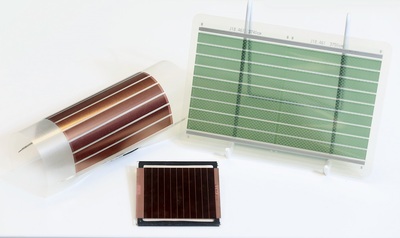New mechanism developed for high-efficiency organic solar cells

Organic photovoltaics (OPVs) are an economical next-generational solar cell technology for scalable clean energy and wearable electronics. But the energy conversion loss due to the recombination of photo-generated charge carriers in OPVs has hindered further enhancement of their power conversion efficiency (PCE). Researchers from City University of Hong Kong (CityU) have developed a novel device-engineering strategy to successfully suppress the energy conversion loss. The best-performing OPVs developed by the CityU team have achieved PCE of over 19%, which is reportedly higher than the existing level, with researchers expecting to exceed 20% soon. The discovery is promising for the commercialisation of OPVs; the research findings were published in the scientific journal Nature Energy.
OPVs, a solar cell technology based on organic semiconductors, are regarded as a promising candidate for clean energy due to their low material toxicity and vast molecular tunability in photoactive materials. Most high-performing organic photovoltaics adopt a “bulk-heterojunction” (BHJ) structure, consisting of electron donor and acceptor materials intermixed throughout the active layer of the device.
When converting sunlight into electricity in OPVs, energy from sunlight creates excitons (a negatively charged electron and a positively charged hole bound together), which then dissociate into free electrons and holes at the nanoscale donor-acceptor interface, generating charge carriers (photocurrent) and hence electricity. However, if these charge carriers are not collected by the electrodes and encounter each other again at the donor–acceptor interface, they may recombine to form a low-energy “spin-triplet exciton” (T1), which consecutively relaxes back to the ground state, causing energy loss in the form of heat and photocurrent loss. This irreversible process limits the maximum achievable PCE of OPVs.
A research team led by Professor Alex Jen Kwan-yue, Lee Shau Kee Chair Professor of Materials Science, invented a novel device-engineering strategy to suppress T1 formation and minimise the associated recombination loss, which led to the rise in efficiency of OPVs.
“We are the first team that managed to modulate T1 formation through device engineering without changing the properties of the photoactive materials and to reveal the fundamental mechanism. Using this strategy, we have expanded it to 14 other material systems to show the universal applicability of this study,” Jen said.
By replacing the traditional highly intermixed bulk-heterojunction (BHJ) architecture inside the solar cell with a de-mixed “planar-mixed heterojunction” (PMHJ) to reduce the donor-acceptor interface inside the active layer of OPVs, the researchers alleviated the energy conversion loss in OPVs by suppressing the recombination of the charge carriers. This discovery maximised the photocurrent of OPVs, resulting in devices with a high PCE of over 19%. According to Jen, the researchers’ de-mixed planar-mixed heterojunction (PMHJ) strategy is capable of suppressing the loss pathway mediated by charge-transfer states at the donor–acceptor interface.
The researchers revealed that having fewer donor–acceptor contacts in PMHJ minimises the chance of recombination and results in reduced T1 concentration. This fundamentally changes researchers’ previous impression of OPVs — that the more donor–acceptor contacts, the higher the OPV performance. Dr Francis Lin, who also took part in the study, said the achieved optimum photovoltage–photocurrent trade-off resulting from the researchers’ strategy enables OPVs with competitive efficiency comparable to that of inorganic photovoltaics. Lin added that organic photovoltaic cells have several advantages over inorganic counterparts, such as being lightweight and flexible, like a thin plastic film, and allowing cost-effective fabrication, using roll-to-roll printing production.
The latest discovery provides a comprehensive basis for future organic photovoltaics to reach their full promise and stimulate a new wave of studies on the versatile photophysical processes in organic semiconductors. The researchers are applying for a patent for the discovery. “We hope to further boost the performance of OPVs following our novel discovery of modulating the photophysical processes. This redefines the maximum potential of OPVs to facilitate their commercialisation,” Jen said.
Predictive AI model enhances solid-state battery design
ECU researchers are working on ways to make solid-state batteries more reliable with the help of...
Boosting performance of aqueous zinc–iodine batteries
Engineers from the University of Adelaide have enhanced aqueous zinc–iodine batteries using...
Sodium-ion battery breakthrough boosts energy storage
Scientists have discovered that leaving water inside a key material, rather than removing it,...






